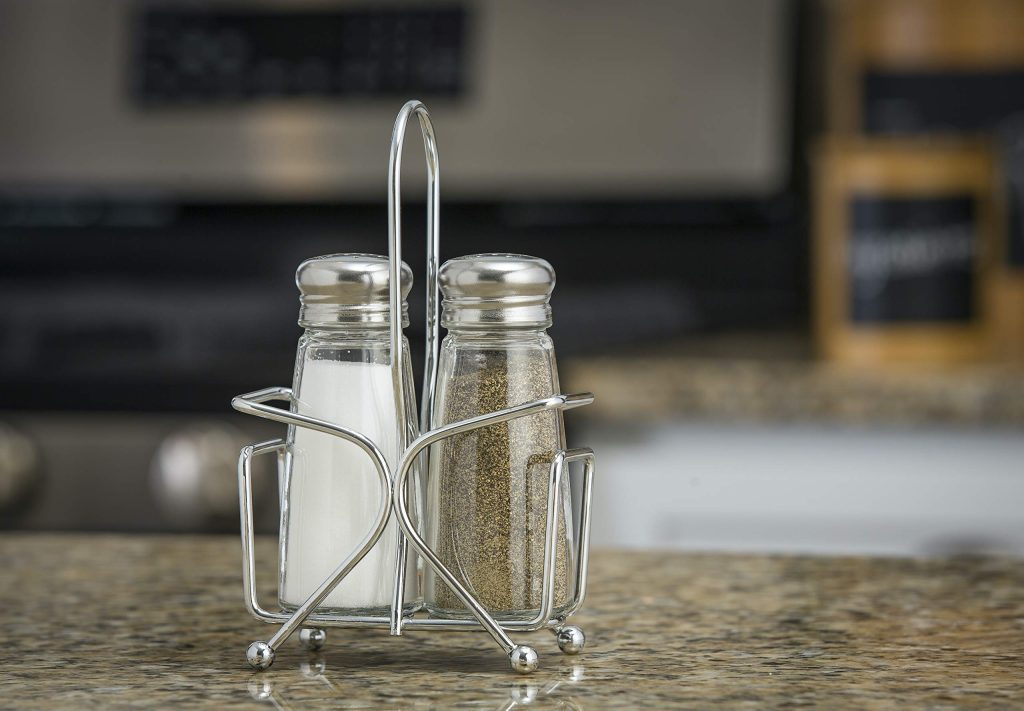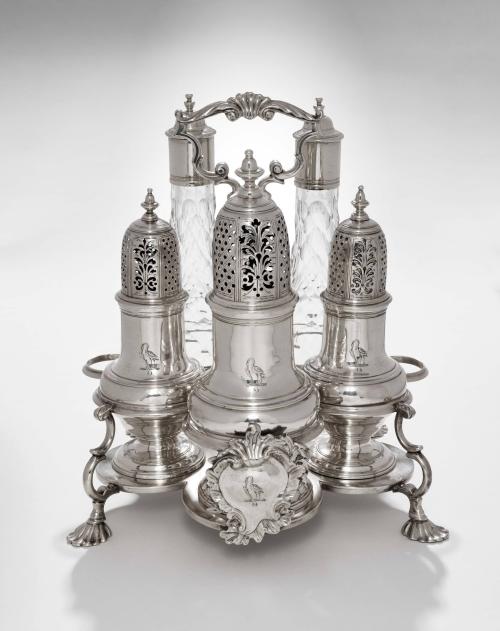The Mystery of the Third Shaker
Walk into most restaurants in the United States, and you’ll find that the tables are set roughly the same way—there are plates, forks, knives, spoons, napkins, and a glass for your water. There are probably some condiments also there waiting for you: sugar, perhaps, maybe ketchup, and maybe oil and vinegar. And of course, the salt and pepper shakers, as seen above. These are mainstays of the dinner table, and ones we often take for granted.
And apparently, we don’t miss them when they’re gone — if the history of the third shaker is any indication, at least.
Yes, the third shaker. Let’s start with another picture.
That’s a cruet stand — basically, a holder for the shakers and the bottles of liquid you’d find on a table, via the Colonial Williamsburg Foundation. The cruet stand is from the 1750s. There are two bottles (called cruets) in the back of the stand and, as you can see, there are three shakers. One was for salt, one was for pepper — there’s little debate about that. But the third?
There are a few theories. Some think that the third shaker was used for sugar — it’s common to find a large sugar shaker on tables at diners and the like today. But that probably wasn’t true 250 years ago, as sugar was a lot more expensive then and seen as a luxury, not an everyday additive. Another theory is that the third shaker featured dehydrated vinegar, which, while possible, would be strange given that the bottle next to it had the typical (and liquid) vinegar in it. And there are others out there suggesting various other spices were the go-tos, such as dill and cardamom.
But the most likely theory is one we’d not consider for our tables today. In his 2010 book “At Home: A Short History of Private Life,” journalist Bill Bryson explored the stories of the items and practices common in our daily home lives, but warrant more than a passing thought. He concludes “what went into the third caster in unknown” but that “it is generally presumed to have been dried mustard, but that is really because no one can think of anything more likely.” There is a bit of documentary evidence to support the mustard theory — this catalog from 1897 shows a three-shaker cruet set among many two-shaker ones, and notes that the third shaker is for mustard; and this 1922 Sears Roebuck catalog (check out the left column) shows a “mounted glass caster set” that contains a “mustard bottle.”
But if that’s the case, Bryson notes, the third shaker wasn’t often used: “There’s no evidence to suggest that mustard was ever desired or utilized in such ready fashion by diners at any time in history.” If it was, it gave way to liquid mustard as refrigeration became more widespread. And if anything else was in that shaker, it wasn’t popular enough to warrant its continued inclusion in the cruet stand.
Either way, the third shaker is long gone — and the mustard is now in the fridge.
Bonus fact: If you’re a fan of sushi, you’re probably familiar with wasabi — or you think you are, but you’ve probably never eaten it. Wasabi is a plant native to Japan’s river valleys and isn’t easy to grow and has to be served fresh, as Mental Floss explains: “Real wasabi, until grated from the root, isn’t spicy. When grated in a circular, clockwise motion, a paste is formed and hot vapors are released, and traditional Japanese restaurants will grate fresh wasabi to order. Wasabi loses its strength after a mere fifteen to twenty minutes, so it needs to be served immediately after it’s turned into a paste.” That makes it not-so-economical to serve. (Per Mental Floss, “If you were to be served a small serving of wasabi alongside your sushi, you would need to pay about three to five dollars for the wasabi alone.”) So most restaurants outside of Japan don’t serve it. Instead, the green spicy stuff next to your California roll is a mix of horseradish and mustard — and green food coloring.
From the Archives: The Great Mustard Pickle Panic of 2016: This isn’t technically about mustard, but about pickles. Close enough.


